Choosing the right hockey stick height is crucial for optimal performance and comfort during gameplay. This guide provides essential tips and measurements to ensure a perfect fit, enhancing control and overall playing experience.
How to Measure Hockey Stick Height Without Skates
Stand barefoot and hold the stick vertically beside you. Measure from the ground to the top of the stick, ensuring it reaches just below your hip bone for optimal length.
Measuring from the Ground to the Stick’s End
Place the stick vertically on the ground and measure its length using a tape measure. Ensure the stick reaches just below your hip bone when standing barefoot. This method provides an accurate measurement without skates, helping you determine the ideal length for comfort and performance. Adjust the stick as needed to achieve the perfect fit.
Ensuring the Stick Reaches the Hip Bone
When measuring without skates, the stick should reach just below the hip bone. Stand barefoot and hold the stick vertically. The top of the stick should align with the hip bone for optimal length. This ensures proper balance and control, allowing for effective puck handling and shooting. Adjust the stick length to meet this guideline for the best performance.
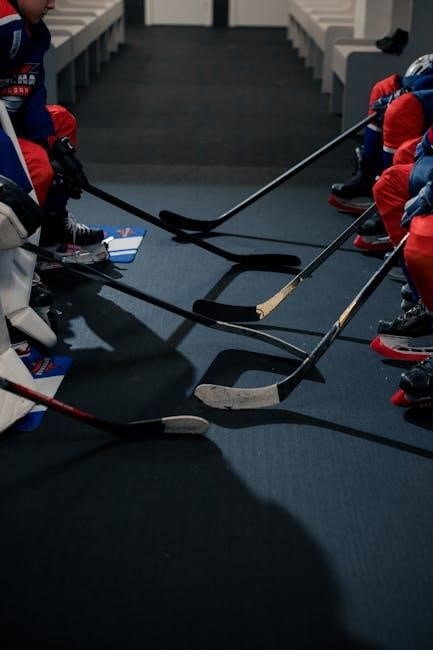
How to Measure Hockey Stick Height With Skates On
Stand with skates on, hold the stick vertically. The top should reach your chin or nose for proper length, ensuring the blade touches the ground.
Stand with Skates On and Stick in Hand
Put on your skates and hold the hockey stick upright in front of you. The stick should extend from the ground to just below your chin or nose when standing straight. This measurement ensures the stick is proportional to your height while wearing skates, providing optimal reach and control during gameplay. Proper fit enhances performance and comfort.
Adjusting the Stick to Chin Height
When wearing skates, hold the stick upright in front of you. The stick should reach just below your chin or nose for proper fit. This height ensures optimal control and maneuverability. A stick too long may hinder puck handling, while one too short can limit reach. Adjusting to chin height balances performance and comfort, aligning with standard recommendations for players.
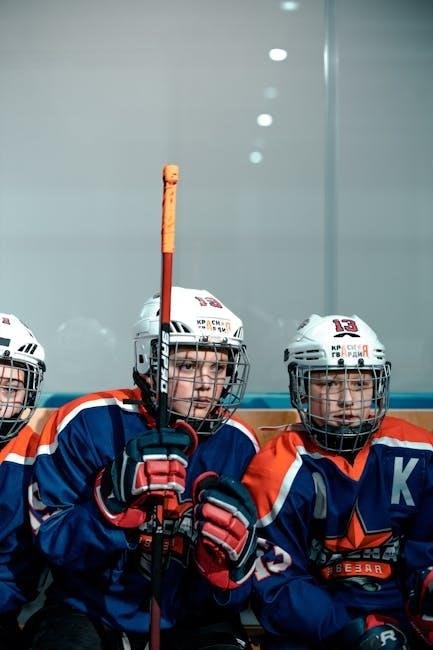
General Hockey Stick Height Guidelines
Hockey sticks typically range from 28 to 37;5 inches, with lengths suited to player height. Sticks should reach the hip bone when standing without skates and chin height with skates on for optimal performance.
Stick Length Based on Player Height
Hockey stick length is tailored to player height for optimal performance. Youth sticks range from 38-44 inches, junior sticks from 46-53 inches, intermediate at 54 inches, and senior sticks from 56-63 inches. Proper sizing ensures the stick reaches the hip bone when standing without skates and chin height with skates on, allowing for better control and maneuverability during gameplay.
Standard Size Charts for Junior and Senior Players
Standard size charts categorize stick lengths by player height. Junior players typically use sticks between 46-53 inches, while senior players opt for 56-63 inches. These charts ensure proper fit, balancing reach and control. They are designed to match the physical stature of players, promoting optimal performance and comfort during gameplay. Using these charts helps players select the ideal stick size for their needs.
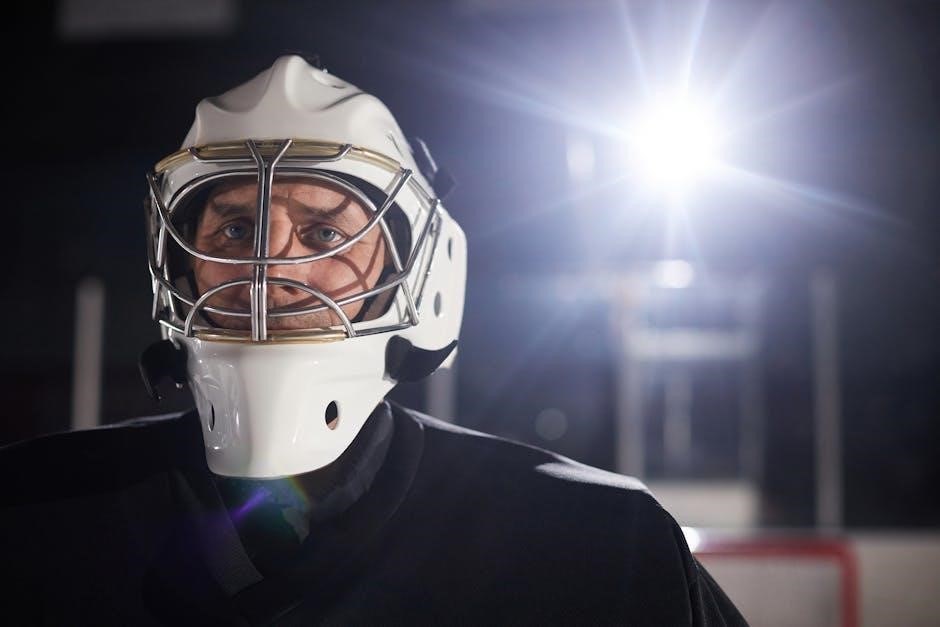
Factors Influencing Hockey Stick Height Choice
Player position, skill level, and skating style influence stick height choice. Forwards may prefer shorter sticks for agility, while defensemen opt for longer sticks for reach and control.
Player Position and Skill Level
Player position and skill level significantly impact hockey stick height. Forwards often prefer shorter sticks for better puck control and agility, while defensemen favor longer sticks for reach and blocking shots. Goalies require extra-length sticks for optimal coverage. Skill level also matters, as advanced players may prefer shorter sticks for quicker handling, while developing players might opt for slightly longer sticks to build confidence and reach.
Balance Between Reach and Control
Finding the right balance between reach and control is essential for optimal performance. A longer stick increases reach but may reduce control, while a shorter stick enhances control but limits reach. Players must weigh these factors based on their position and skill level to determine the ideal stick height that suits their gameplay needs and preferences.

How to Measure Your Hockey Stick
To measure your hockey stick, stand without skates and ensure the stick reaches your hip bone. With skates on, the stick should reach your chin. Use a measuring tape for accuracy and check against body landmarks to find the perfect fit.
Using a Measuring Tape for Accuracy
For precise measurements, use a measuring tape to determine the stick’s length. Stand without skates and measure from the ground to the stick’s end, ensuring it reaches your hip bone. With skates on, the tape should show the stick reaching your chin. This method ensures accuracy and helps maintain proper posture and control during gameplay, optimizing performance and comfort.
Checking Against Body Landmarks
Using body landmarks ensures accurate sizing. Without skates, the stick should reach the top of your hip bone. With skates on, it should align with your chin or slightly below. This method provides a consistent reference point, allowing you to maintain proper posture and control. Aligning the stick with these landmarks helps achieve the perfect balance between reach and maneuverability, ensuring optimal performance and comfort during gameplay.
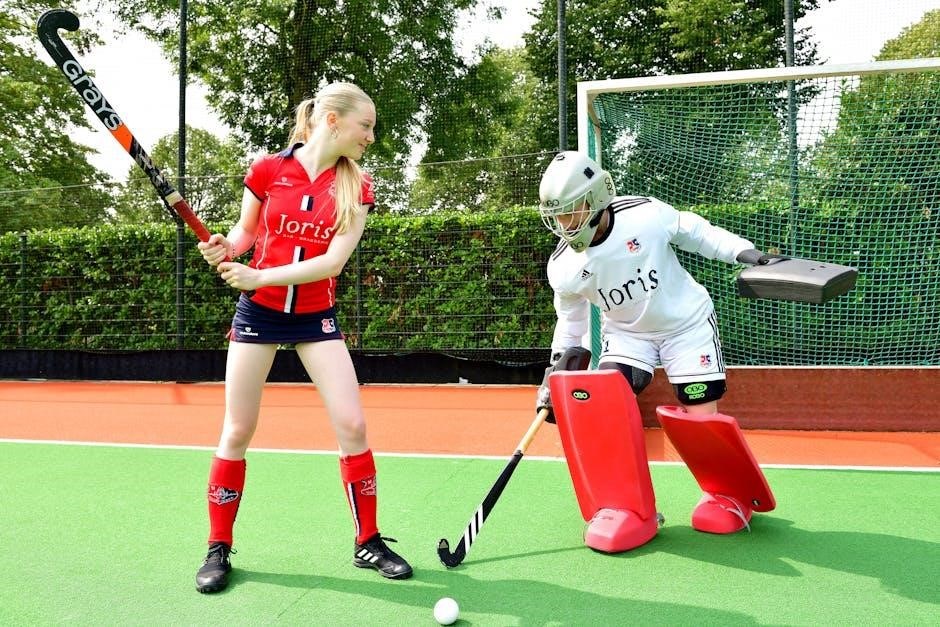
Why Proper Hockey Stick Length Matters
Proper stick length enhances puck handling, shooting accuracy, and overall performance. It ensures comfort and control, allowing players to maintain optimal posture and technique during gameplay.
Impact on Puck Handling and Shooting
Proper hockey stick height significantly affects puck handling and shooting. A stick that’s too long can make handling cumbersome, while one that’s too short may reduce shooting power. Optimal length ensures better control, allowing precise stickhandling and more accurate, powerful shots. Correct sizing enables players to maintain proper technique, enhancing overall performance in critical game situations.
Effect on Performance and Comfort
A properly sized hockey stick enhances performance by improving reach, control, and balance. It ensures comfortable gameplay, reducing fatigue and discomfort during extended play. A stick that fits well allows players to maintain proper posture, reducing strain on the back and shoulders. Correct height also prevents awkward positioning, enabling better mobility and focus on the game, which is essential for peak performance and player safety.
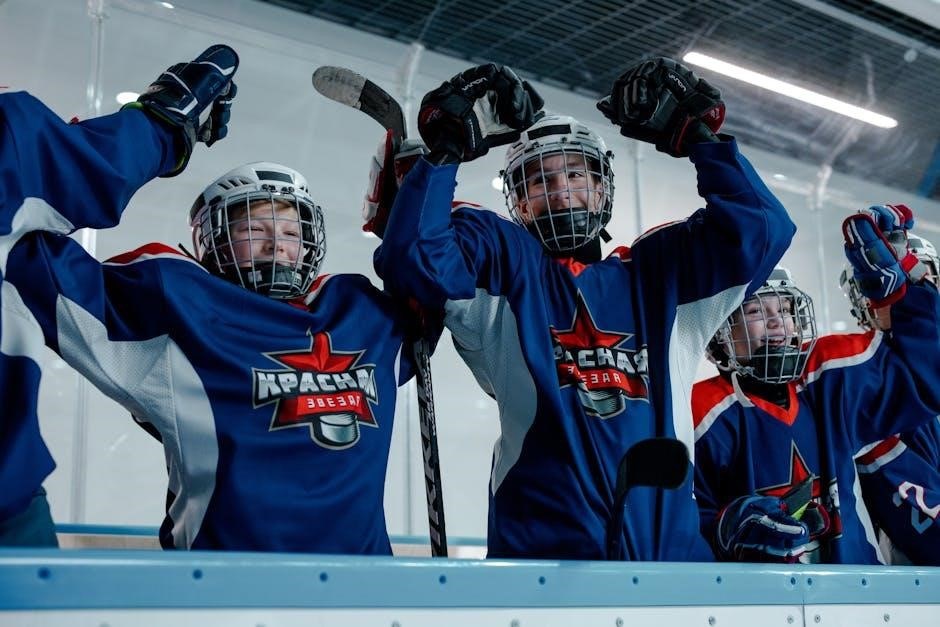
Hockey Stick Lie and Its Importance
Hockey stick lie determines the angle between the shaft and blade, crucial for stickhandling and shooting. Proper lie enhances control, balance, and overall performance, tailored to individual styles.
Understanding Stick Lie Measurements
Stick lie refers to the angle between the shaft and blade, impacting puck control and shooting. Common lies range from 5 to 7, with lower numbers meaning a more upright blade. Proper lie alignment with skating stance enhances performance, as it affects how the blade interacts with the ice. Measuring lie ensures compatibility with individual skating styles, optimizing stickhandling and shooting accuracy for players of all levels.
Matching Lie to Playing Style
The stick’s lie should align with a player’s position and style. Forwards often prefer a lower lie for better puck control, while defensemen may opt for a higher lie to improve slapshot accuracy. Goalies require a unique lie for optimal reach and handling. Matching the lie to your playing style ensures maximum efficiency, whether you’re stickhandling, shooting, or defending, enhancing overall gameplay effectiveness and personal comfort.

Senior vs. Youth Hockey Sticks
Senior hockey sticks are longer with more flex, catering to advanced players. Youth sticks are shorter and stiffer, designed for younger, developing players.
Differences in Length and Flex
Senior hockey sticks are longer, typically ranging from 56 to 63 inches, with more flex for advanced players. Youth sticks are shorter, usually 38-44 inches, and stiffer to help younger players control the puck effectively. The length and flex differences are designed to accommodate skill levels, ensuring optimal performance for both senior and youth players during gameplay.
Recommended Sizes for Youth Players
For youth players, hockey sticks typically range from 38 to 44 inches in length. The ideal size depends on the player’s height, with sticks generally recommended to reach the hip bone when worn with skates. Proper sizing ensures better puck control and handling, making it easier for young players to develop their skills effectively during training and gameplay.
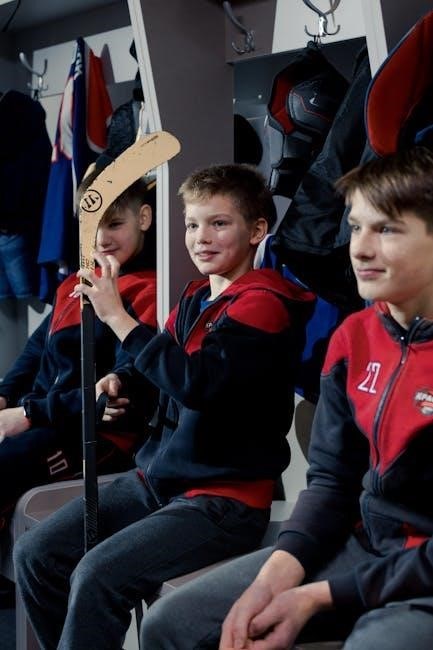
Popular Hockey Stick Brands and Their Size Guides
Brands like Bauer, CCM, and True Hockey offer detailed size charts, ensuring players find the ideal stick length. Custom fit options are also available for precise measurements.
Brands Offering Custom Fit Options
Top brands like Bauer, CCM, and True Hockey provide custom fit options, allowing players to tailor stick length and flex to their preferences. These brands often feature size charts and measurement guides to help determine the ideal stick height for players of all levels.
Custom fit options ensure optimal performance by matching the stick to the player’s height, skating style, and position. This personalized approach helps maintain proper technique and comfort during gameplay, making it a popular choice among serious hockey athletes.
Comparing Size Charts Across Brands
Size charts for hockey sticks vary slightly between brands, but most follow a similar principle of matching stick length to player height. Brands like Bauer, CCM, and True Hockey provide detailed size guides, ensuring players can find the perfect fit. Some brands also offer customizable options, while others focus on standard measurements. Comparing these charts helps players choose the best stick for their height and playing style.
Common Mistakes in Choosing Stick Height
Common mistakes include choosing sticks too long or short, not measuring with skates on, and ignoring body landmarks like hip or chin height, affecting performance and comfort.
Choosing a Stick Too Long or Too Short
A stick too long can hinder control and accuracy, while a stick too short may limit reach and puck-handling ability. Proper height ensures optimal performance, as it balances comfort and effectiveness during gameplay. Many players overlook this critical factor, leading to subpar performance. Ensuring the stick aligns with body landmarks, like hip or chin height, is essential for avoiding this common mistake and maximizing playing potential.
Not Considering Skates in Measurements
Failing to account for skates during stick height measurement is a common error. Skates add several inches to a player’s height, so measuring without them often results in a stick that’s too short. This oversight can lead to discomfort, poor posture, and reduced performance. Always measure stick height with skates on to ensure accuracy and optimal fit for better control and gameplay experience.
Choosing the right hockey stick height is essential for performance and comfort. By measuring correctly with skates on and considering player position, skill level, and personal preference, you can find the ideal stick. Avoid common mistakes like ignoring skate height or choosing sticks too long or short. Proper fit enhances control, shooting, and overall gameplay, ensuring a more enjoyable and effective hockey experience for players of all levels.


